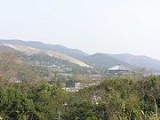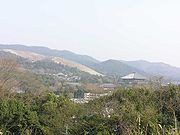
Matsunaga Hisahide
Encyclopedia

Daimyo
is a generic term referring to the powerful territorial lords in pre-modern Japan who ruled most of the country from their vast, hereditary land holdings...
of Japan
Japan
Japan is an island nation in East Asia. Located in the Pacific Ocean, it lies to the east of the Sea of Japan, China, North Korea, South Korea and Russia, stretching from the Sea of Okhotsk in the north to the East China Sea and Taiwan in the south...
following the Sengoku period
Sengoku period
The or Warring States period in Japanese history was a time of social upheaval, political intrigue, and nearly constant military conflict that lasted roughly from the middle of the 15th century to the beginning of the 17th century. The name "Sengoku" was adopted by Japanese historians in reference...
of the 16th century.
A companion of Miyoshi Chokei
Miyoshi Chokei
, eldest son of Miyoshi Motonaga, was a Japanese samurai and daimyo who was lord of the Miyoshi clan during the Sengoku period. Nagayoshi held the court titles of Shūri-dayū and Chikuzen no Kami , and was also known by the more Sinic reading of his name: Chōkei...
, he was a retainer of Miyoshi Masanaga
Miyoshi Masanaga
was a Japanese samurai of the Sengoku period, a member of the Miyoshi clan who served as daimyo of Awa. He is remembered as the cousin of Miyoshi Chōkei. Masanaga had very strong relations with the Ikeda clan, as Ikeda Nagamasa was his son-in-law. Due to this strong relation between the families,...
from the 1540s. He directed the conquest of the province of Yamato in the 1560s and by 1564 had built a sufficient power-base to be effectively independent. It is believed that he was conspiring against Chokei during this period, from 1561 to 1563 three of Chokei's brothers and his son Yoshioki died. This left Miyoshi Yoshitsugu
Miyoshi Yoshitsugu
, adopted son of Nagayoshi, was a samurai of the Sengoku period who was practically the last head of Miyoshi clan, daimyo of Kawachi province of Japan....
the adopted heir when Chokei died in 1564, too young to rule. Three men shared his guardianship - Miyoshi Nagayuki, Miyoshi Masayasu, and Iwanari Tomomichi
Iwanari Tomomichi
was a Japanese samurai of the 16th century. Also known as Ishinari Tomomichi , he was a retainer of the Miyoshi clan, and held the title of Chikara-no-suke...
.
In 1565, the guardians and Hisahide worked together and dispatched an army to capture Ashikaga Yoshiteru
Ashikaga Yoshiteru
, also known as Yoshifushi or Yoshifuji, was the 13th shogun of the Ashikaga shogunate who reigned from 1546 to 1565 during the late Muromachi period of Japan. He was the eldest son of the 12th shogun, Ashikaga Yoshiharu; and his mother was a daughter of Konoe Taneie...
, the shogun
Shogun
A was one of the hereditary military dictators of Japan from 1192 to 1867. In this period, the shoguns, or their shikken regents , were the de facto rulers of Japan though they were nominally appointed by the emperor...
, who was then either murdered or forced to commit suicide. His brother Ashikaga Yoshiaki
Ashikaga Yoshiaki
was the 15th shogun of the Ashikaga shogunate in Japan who reigned from 1568 to 1573. His father, Ashikaga Yoshiharu was the twelfth shogun, and his brother, Ashikaga Yoshiteru was the thirteenth shogun....
fled and the shogun was replaced by his young cousin, Yoshihide
Ashikaga Yoshihide
was the 14th shogun of the Ashikaga shogunate who held nominal power for a few months in 1568 during the Muromachi period of Japan. When he became shogun, he changed his name to Yoshinaga, but he is more conventionally recognized today by the name Yoshihide....
.
In 1566, fighting started between Hisahide and the Miyoshi. Initially the forces of Hisahide were unsuccessful and his apparent destruction of the Buddhist Tōdai-ji
Todai-ji
, is a Buddhist temple complex located in the city of Nara, Japan. Its Great Buddha Hall , the largest wooden building in the world, houses the world's largest bronze statue of the Buddha Vairocana, known in Japanese simply as Daibutsu . The temple also serves as the Japanese headquarters of the ...
in Nara was considered an act of infamy.
In 1568 Oda Nobunaga
Oda Nobunaga
was the initiator of the unification of Japan under the shogunate in the late 16th century, which ruled Japan until the Meiji Restoration in 1868. He was also a major daimyo during the Sengoku period of Japanese history. His opus was continued, completed and finalized by his successors Toyotomi...
, with the figurehead Yoshiaki, attacked Hisahide. Nobunaga captured Kyoto in November and Hisahide was forced to surrender. Yoshiaki was made shogun, a post he held only until 1573 when he attempted to remove himself from Nobunaga's power. Hisahide kept control of the Yamato and served Nobunaga in his extended campaigns against the Miyoshi and others, for a while. In 1573 Hisahide briefly allied with the Miyoshi, but when the hope for successes were not achieved he returned to Nobunaga to fight the Miyoshi. In 1577 he split with Nobunaga again, this time Nobunaga turned on him and besieged him at Shigisan Castle
Shigisan Castle
' was a Japanese castle of the Sengoku period, controlled by the Kizawa and Matsunaga clans.-Location:The castle was located atop Mount Shigi, on the border of Japan's Kawachi and Yamato provinces...
. Defeated but defiant Hisahide committed suicide, he ordered his head destroyed to prevent it becoming a trophy (in which his son, Matsunaga Kojiro grabbed Matsunaga's head and jumped off the castle wall with his sword through his throat) and also destroyed a priceless tea kettle (Hiragumo) that Nobunaga coveted before he died. His son, Hisamichi, also committed suicide in siege.
Hisahide often appears as a shriveled and scheming old man in fiction. However, this is a fictitious image from his assassinations and the possible destruction of Tōdai-ji
Todai-ji
, is a Buddhist temple complex located in the city of Nara, Japan. Its Great Buddha Hall , the largest wooden building in the world, houses the world's largest bronze statue of the Buddha Vairocana, known in Japanese simply as Daibutsu . The temple also serves as the Japanese headquarters of the ...
. In truth, he was a tall, handsome, and educated man as well as a patron
Patrón
Patrón is a luxury brand of tequila produced in Mexico and sold in hand-blown, individually numbered bottles.Made entirely from Blue Agave "piñas" , Patrón comes in five varieties: Silver, Añejo, Reposado, Gran Patrón Platinum and Gran Patrón Burdeos. Patrón also sells a tequila-coffee blend known...
of arts.

